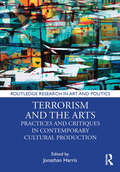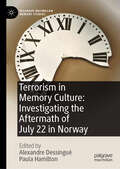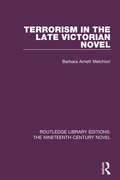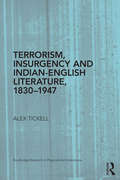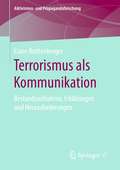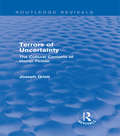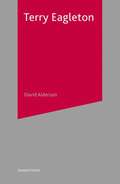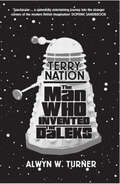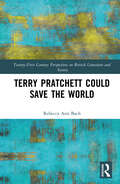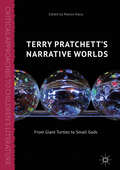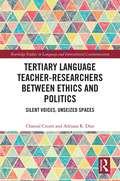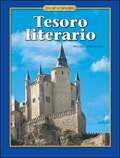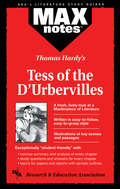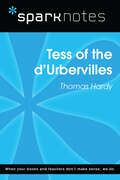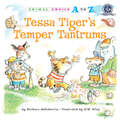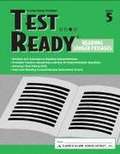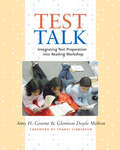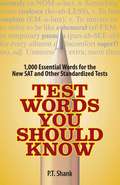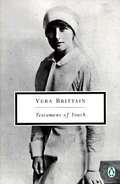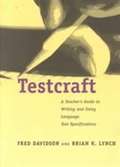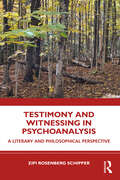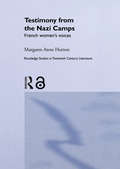- Table View
- List View
Terrorism and the Arts: Practices and Critiques in Contemporary Cultural Production (Routledge Research in Art and Politics)
by Jonathan HarrisThis book assesses the key definitions, forms, contexts and impacts of terrorist activity on the arts in the modern era, using historical and contemporary perspectives. Its empirical case studies include theatre, literature, music, visual art, mass media, film and the mores of ‘ordinary life.’ While its immediate reflective context is Islamic fundamentalist terrorism, the book reviews a broader range of definitions and counter-definitions of 'terrorism', 'state terrorism' and 'states of terror,' examining uses of the terms through a series of comparative analyses. Chapters focus on the intersection of these definitional questions with heuristic analysis of art forms, cultural activities and their socio-historical contexts. This book will be of interest to scholars in art history, terrorism, politics and the media, and visual culture.
Terrorism in Memory Culture: Investigating the Aftermath of July 22 in Norway (Palgrave Macmillan Memory Studies)
by Paula Hamilton Alexandre DessinguéThis edited collection examines the intersection between the developing fields of terrorism and cultural memory studies through a detailed study of the 2011 terrorist attack in Norway. It examines how the work of remembrance has been established through arts such as theatre and fiction, and also architecture, heritage and education. It traces the politics of the remembrance processes and explores the shifting meanings in public memories that change over the thirteen years since the attack, and are constantly being negotiated in response to present circumstances. It also charts general trends in memorialisation: the globalising and digitalising of memory practices, the speed of memorial initiatives, the role of testimony, and the importance of diverse narratives emerging through newer modes of communication. Chapters 10, 13 and 16 are available open access under a Creative Commons Attribution 4.0 International License via link.springer.com
Terrorism in the Late Victorian Novel (Routledge Library Editions: The Nineteenth-Century Novel #28)
by Barbara Arnett MelchioriFirst published in 1985, this book looks at the ways in which the spate of terrorist activity in the 1880s was reflected in the novels of the time. Oscar Wilde, George Gissing, Henry James and George Bernard Shaw among others gave the terrorist venture a position in one or more of their novels. This book examines what these novelists made of terrorism and the way they presented it to their readers. Not all of these novels are high literature or take a committed line on the outrages they describe; nevertheless they accept the assumption that terrorism and social protest were synonymous. This book aims to explain how such a view could be held in the context of Victorian society.
Terrorism, Insurgency and Indian-English Literature, 1830-1947 (Routledge Research in Postcolonial Literatures)
by Alex TickellIn this ground-breaking interdisciplinary study of terrorism, insurgency and the literature of colonial India, Alex Tickell re-envisages the political aesthetics of empire. Organized around key crisis moments in the history of British colonial rule such as the ‘Black Hole’ of Calcutta, the anti-thug campaigns of the 1830s, the 1857 Rebellion, anti-colonial terrorism in Edwardian London and the Amritsar massacre in 1919, this timely book reveals how the terrorizing threat of violence mutually defined discursive relations between colonizer and colonized. Based on original research and drawing on theoretical work on sovereignty and the exception, this book examines Indian-English literary traditions in transaction and covers fiction and journalism by both colonial and Indian authors. It includes critical readings of several significant early Indian works for the first time: from neglected fictions such as Kylas Chunder Dutt’s story of anticolonial rebellion A Journal of Forty-Eight Hours of the Year 1945 (1835) and Sarath Kumar Ghosh’s nationalist epic The Prince of Destiny (1909) to dissident periodicals like Hurrish Chunder Mookerji’s Hindoo Patriot (1856–66) and Shyamaji Krishnavarma’s Indian Sociologist (1905–14). These are read alongside canonical works by metropolitan and ‘Anglo-Indian’ authors such as Philip Meadows Taylor’s Confessions of a Thug (1839), Rudyard Kipling’s short fictions, and novels by Edmund Candler and E. M. Forster. Reflecting on the wider cross-cultural politics of terror during the Indian independence struggle, Tickell also reappraises sacrificial violence in Indian revolutionary nationalism and locates Gandhi’s philosophy of ahimsa or non-violence as an inspired tactical response to the terror-effects of colonial rule.
Terrorismus als Kommunikation: Bestandsaufnahme, Erklärungen und Herausforderungen (Aktivismus- und Propagandaforschung)
by Liane RothenbergerKommunikationstheorien und Terrorismus – wie lässt sich hier eine Verbindung schaffen? Terrorismus ist ein in der heutigen Zeit dominantes Thema: Es bestimmt zuweilen die öffentliche politische Diskussion wie auch private Gespräche. Die Kommunikationswissenschaft kann dazu beitragen, das Phänomen Terrorismus weiter zu durchdringen, und wichtige Puzzlesteine liefern, es in seiner Gesamtheit zu erfassen. Die Entwicklung der Medienkompetenz mancher Terroristengruppen drängt es geradezu auf, das „Gesellschaftsproblem Terrorismus“ mithilfe einer „kommunikationswissenschaftlichen Brille“ anzugehen.
Terrors of Uncertainty: The Cultural Contexts of Horror Fiction (Routledge Revivals)
by Joseph GrixtiFrom Frankenstein and Dracula to Psycho and The Chainsaw Massacre, horror fiction has provided our culture with some of its most enduring themes and narratives. Considering horror fiction both as a genre and as a social phenomenon, Joseph Grixti provides a theoretical and historical framework for reconsidering horror and the cultural apparatus that surrounds it. First published in 1989, this book looks at shifts in the genre’s meaning – its fascination with excess, its commentaries on the categories and boundaries of culture – and at interpretations of horror from psychology, psychoanalysis, sociology, cultural and media studies. Terrors of Uncertainty brings together a provocative range of perspectives from across the disciplines, which combine to raise important questions about the relationship between fiction and society, and the way in which we use fiction to resolve or evade our fears of uncertainty.
Terry Eagleton
by David AldersonTerry Eagleton is the foremost Marxist cultural theorist of our time. In the first book-length study of this highly influential figure, David Alderson provides detailed discussions of Eagleton's Marxism and his engagements with postmodernism, as well as an evaluation of his interventions in Irish Studies. Each of the chapters in this important intervention in current theoretical debates offers accessible contextualization of the key issues and provides detailed analyses of Eagleton's literary criticism. Alderson shows that the complex relations between nature, culture and ideology, body, subjectivity and authority are at the heart of Eagleton's ethical and political concerns. He goes on to demonstrate that these relations inform the theorist's critical examinations of such literary works as Wuthering Heights and The Merchant of Venice, and his treatment of W. B. Yeats and Oscar Wilde.
Terry Nation: The Man Who Invented the Daleks
by Alwyn W. TurnerA “splendidly entertaining” biography of the British tv writer acclaimed for his invention of a fictional alien race for Doctor Who (Dominic Sandrook, author of State of Emergency—The Way We Were: Britain 1970–1974).The Daleks are one of the most iconic and fearsome creations in television history. Since their first appearance in 1963, they have simultaneously fascinated and terrified generations of children, their instant success ensuring, and sometimes eclipsing, that of Doctor Who. They sprang from the imagination of Terry Nation, a failed stand-up comic who became one of the most prolific writers for television that Britain ever produced. Survivors, his vision of a post-apocalyptic England, so haunted audiences in the Seventies that the BBC revived it over thirty years on, and Blake’s 7, constantly rumored for return, endures as a cult sci-fi classic. But it is for his genocidal pepperpots that Nation is most often remembered, and now, more than 50 years after their creation they continue to top the Saturday-night ratings. Yet while the Daleks brought him notoriety and riches, Nation played a much wider role in British broadcasting’s golden age. He wrote for Spike Milligan, Frankie Howerd and an increasingly troubled Tony Hancock, and as one of the key figures behind the adventure series of the Sixties—including The Avengers, The Saint and The Persuaders!—he turned the pulp classics of his boyhood into a major British export. In The Man Who Invented the Daleks, acclaimed cultural historian Alwyn W. Turner, explores the curious and contested origins of Doctor Who’s greatest villains, and sheds light on a strange world of ambitious young writers, producers and performers without whom British culture today would look very different.
Terry Pratchett Could Save the World (21st Century Perspectives on British Literature and Society)
by Rebecca Ann BachThis monograph contends that attending to Pratchett’s work could help to save our world. It draws attention to the astonishing capacity of Pratchett’s novels to inspire and argues that Pratchett’s fantasy novels directly address many of the most significant challenges people in the world face: the explosion of weapons technology; the myriad issues involved in the envelopment of human life by corporatized information technology; the destructive human inattention to, and interactions with, the Earth and its life forms; and the problem of devalued labor. Paradoxically, it is Pratchett’s choice of fantasy that lets him address the reality of major issues that humanity and the rest of life confront now. Pratchett’s novels show us how to better understand and confront the problems the world is contending with. The book will interest both scholars and fans.
Terry Pratchett Could Save the World (Twenty-First Century Perspectives on British Literature and Society)
by Rebecca Ann BachThis monograph contends that attending to Pratchett’s work could help to save our world. It draws attention to the astonishing capacity of Pratchett’s novels to inspire and argues that Pratchett’s fantasy novels directly address many of the most significant challenges people in the world face: the explosion of weapons technology; the myriad issues involved in the envelopment of human life by corporatized information technology; the destructive human inattention to, and interactions with, the Earth and its life forms; and the problem of devalued labor. Paradoxically, it is Pratchett’s choice of fantasy that lets him address the reality of major issues that humanity and the rest of life confront now. Pratchett’s novels show us how to better understand and confront the problems the world is contending with. The book will interest both scholars and fans.
Terry Pratchett's Narrative Worlds
by Marion RanaThis book highlights the multi-dimensionality of the work of British fantasy writer and Discworld creator Terry Pratchett. Taking into account content, political commentary, and literary technique, it explores the impact of Pratchett's work on fantasy writing and genre conventions.With chapters on gender, multiculturalism, secularism, education, and relativism, Section One focuses on different characters’ situatedness within Pratchett’s novels and what this may tell us about the direction of his social, religious and political criticism. Section Two discusses the aesthetic form that this criticism takes, and analyses the post- and meta-modern aspects of Pratchett’s writing, his use of humour, and genre adaptations and deconstructions. This is the ideal collection for any literary and cultural studies scholar, researcher or student interested in fantasy and popular culture in general, and in Terry Pratchett in particular.
Tertiary Language Teacher-Researchers Between Ethics and Politics: Silent Voices, Unseized Spaces (Routledge Studies in Language and Intercultural Communication)
by Chantal Crozet Adriana R. DíazBringing together a range of perspectives from tertiary language and culture teachers and researchers, this volume highlights the need for greater critical engagement with the question of language teacher identity, agency and responsibility in light of an ever changing global socio-political and cultural landscape. The book examines the ways in which various moral, ethical, and ideological dimensions increasingly inform language teaching practice for tertiary modern/foreign language teachers, both collectively as a profession but also at the individual level in everyday classroom situations. Employing a narrative inquiry research approach which combines brief autobiographical reflections with semi-structured interview data, the volume provides a comprehensive portrait of the processes ten teacher-researchers in Australia working across five different languages engage in as they seek to position themselves more purposefully within a critical, political and ethical framework of teaching practice. The book will serve as a springboard from which to promote greater understanding and discussion of the impact of globalisation and social justice corollaries within the field, as well as to mediate the gap between language teaching theory and practice, making this key reading for graduate students and researchers in intercultural communication, language teaching, and language teacher education.
Tesoro Literario (Spanish Level 5 Series)
by McGraw HillAn advanced program for your level 5 Spanish students! Tesoro literario is an advanced Spanish text that contains 10 units, each focusing on a different literary genre and related theme. Each unit contains an introduction of the genre, a selection of literary works that represents that genre, comprehension exercises, vocabulary, as well as written and oral exercises that promote critical thinking, opportunities for conversation, and a comprehensive review of a few structure points.
Tesoros de Lectura 2.1 (Texas)
by Elva Duran Jana Echevarría David J. Francis Irma M. Olmedo Gilberto D. Soto Josefina V. TinajeroA Spanish book about literature
Tess Builds a Snowman (Learn to Write)
by Rozanne Lanczak WilliamsEach book in this delightful collection introduces a different form of writing. These engaging tales use fun-loving characters to motivate and encourage young readers to want to write on their own. At the end of each book, a "Your Turn to Write" page provides entertaining activities designed to build K-2 writing skills. Children simply follow the example of characters in the story to create posters, journal entries, stories, friendly letters, and more! Great for ESL/ELL! Tess Builds a Snowman emphasizes the writing directions writing concept.
Tess of the D'Urbervilles (MAXnotes Literature Guides)
by Charles GrimesREA's MAXnotes for Thomas Hardy's Tess of the D'Urbervilles MAXnotes offer a fresh look at masterpieces of literature, presented in a lively and interesting fashion. Written by literary experts who currently teach the subject, MAXnotes will enhance your understanding and enjoyment of the work. MAXnotes are designed to stimulate independent thought about the literary work by raising various issues and thought-provoking ideas and questions. MAXnotes cover the essentials of what one should know about each work, including an overall summary, character lists, an explanation and discussion of the plot, the work's historical context, illustrations to convey the mood of the work, and a biography of the author. Each chapter is individually summarized and analyzed, and has study questions and answers.
Tess of the d'Urbervilles (SparkNotes Literature Guide Series)
by SparkNotesTess of the d'Urbervilles (SparkNotes Literature Guide) by Thomas Hardy Making the reading experience fun! Created by Harvard students for students everywhere, SparkNotes is a new breed of study guide: smarter, better, faster. Geared to what today's students need to know, SparkNotes provide: *Chapter-by-chapter analysis *Explanations of key themes, motifs, and symbols *A review quiz and essay topics Lively and accessible, these guides are perfect for late-night studying and writing papers
Tessa Tiger's Temper Tantrums (Animal Antics A to Z)
by Barbara deRubertisTessa Tiger likes to play sports—but NOT when she loses. She stomps and storms until her friends don’t want to play with her anymore. Can Tessa change her attitude and make T-ball fun again—for everyone?
Test Ready Reading Longer Passages: Book 5
by Curriculum AssociatesTest Ready, Reading Longer Passages, Book 5 (A Quick-Study Program, reviews key concepts in reading comprehension, provides practice answering a variety of comprehension questions, develops test-taking skills, improves reading comprehension assessment scores).
Test Talk: Integrating Test Preparation into Reading Workshop
by Glennon Doyle Melton Amy H. GreeneUnder No Child Left Behind, nearly every teacher faces a high-stakes balancing act; managing the often incompatible responsibilities of teaching students meaningfully or preparing them for standardized tests. Through their experiences teaching at a school that struggled to meet state test standards driven by NCLB, authors Amy Greene and Glennon Melton discovered a way to raise scores without compromising their strong beliefs about good teaching and learning. Their concise and easy-to-use bookTest Talk: Integrating Test Preparation Into Reading Workshop includes lesson plans and practice passages, as well as sample questions and suggested language to use during lessons. This compelling book shows that teachers don't have to choose between best practice teaching and test preparation; effective test-taking strategies can be integrated into authentic reading instruction. The authors demonstrate how to improve performance on tests without resorting to teaching to the test,- mnemonic devices, or other gimmicks. Instead, they focus on encouraging student readers to explore tests as a specific genre containing unique language, format, and cues. Throughout the book, classroom vignettes show how seamlessly one can weave the test genre into reading workshop and connect those specialized skills to more general reading strategies. It is an invaluable resource for any teacher who struggles with how to prepare kids for tests without sacrificing real teaching and learning.
Test Words You Should Know: 1,000 Essential Words for the New SAT and Other Standardized Texts
by P. T. ShankTest Words You Should Know features 1,000 useful words and definitions that you should not be without. No matter which standardized test you're preparing for, you can ace it with confidence once you have these essential words under your belt. Each entry features a word, a definition and an example showing the word used properly in a sentence. 228 pages with a word list.
Testament to Youth: An Autobiographical Study of the Years 1900-1925
by Vera BrittainIn 1915, the author enlisted as a nurse in the armed services. She explores the politics and hopes of those people who came of age as war broke out.
Testcraft: A Teacher's Guide to Writing and Using Language Test Specifications
by Fred Davidson Brian K. LynchTestcraft is a book about language test development using test specifications, which are generative blueprints for test design. It is intended for language teachers at all career levels, from those in degree or training programs to those who are working in language education settings.
Testimony and Witnessing in Psychoanalysis: A Literary and Philosophical Perspective
by Zipi Rosenberg SchipperIn this fascinating volume, Zipi Rosenberg Schipper approaches the fundamental topic of testimony, seeking to recognize its value as a distinct and vital function in psychoanalytic work, separate from its inherited importance to work on trauma. Rosenberg Schipper introduces a revivifying philosophical, linguistic and psychoanalytic approach to the act of testimony, focusing on the role of witnessing in daily life and the importance it has as a therapeutic tool in psychoanalytic and psychological therapy. Throughout, she pinpoints three key psychoanalytic theories on patient testimony. She begins by looking at Freud’s foundational work on testimony as a means of concealing the unconscious and the questions of credibility in the consulting room this creates before looking at Winnicottian and Kohutian theories, whereby therapists take everything the patient says as a definitive truth. She concludes by looking at the Intersubjective and Relational schools of thought, where the therapist assumes the role of witness. By providing a comprehensive overview of the conflicting theories on the topic, Rosenberg Schipper equips practicing psychoanalysts and analysts-in-training with the tools necessary to utilize this vital therapeutic device and engage with it in treatment for all patients.
Testimony from the Nazi Camps: French Women's Voices (Routledge Studies in Twentieth-Century Literature)
by Margaret Anne HuttonThis interdisciplinary study intergrates historiographical, literary and cultural methodologies in its focus on a little known corpus of testimonial accounts published by French women deported to Nazi camps. Comprising epistemological and literary analyses of the accounts and an examination of the construction of deportee identities, it will interest those working in the fields of modern French literature, genre, women's studies and the Holocaust.
